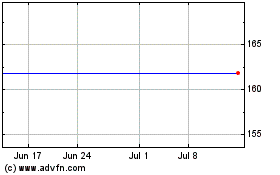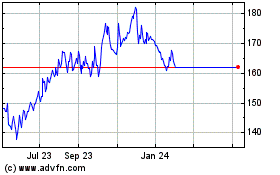The first ship carrying natural gas from the Gulf Coast is
expected to depart soon, marking the emergence of the U.S. as a
major exporter and the globalization of the once highly
regionalized gas trade.
But the debut of a shale-fueled gas-export industry is raising
questions about whether too many sellers are chasing too few
buyers, deepening another boom-and-bust cycle. The price of
liquefied natural gas has dropped 50% over the past year in Asia,
the world's largest and traditionally most lucrative market for
LNG.
The destination of the Gulf Coast gas is likely to be South
America, with Petró leo Brasileiro SA in negotiations to buy the
cargo—which could depart the Louisiana bayou as early as next week,
according to people familiar with the transaction. Petrobras didn't
immediately respond to requests for comment.
It also comes as the company behind the effort, Cheniere Energy
Inc., tries to right itself after a messy boardroom drama that led
to the firing of Chief Executive Charif Souki in December. Since
then, Cheniere—under the leadership of its board of directors—has
scaled back the company's ambitions set by Mr. Souki, laying off an
oil-trading team that he had recruited to expand the business and
filing a lawsuit earlier this month to claw back $46 million of
company funds he invested in what people familiar with the suit say
was his friend's firm.
Cheniere, the first company to secure government permits to
export U.S. gas, was initially founded to import LNG to the U.S.,
but reinvented itself as an exporter after a boom in shale-gas
output. It hasn't turned an annual profit in its 20 years in
business and has become a proxy for a larger debate about LNG.
Two high-profile investors have taken opposite positions in the
stock. Last August, Carl Icahn disclosed a stake in Cheniere and
won two board seats. He currently owns 13.8% of the company. At
about the same time, James Chanos of Kynikos Associates LP began to
bet against Cheniere's stock by shorting it, convinced the LNG glut
is here to stay.
"Much like iron ore and some of the other [resource] debacles of
the last several years, everybody came to the same conclusion at
the same point and began building capacity," Mr. Chanos said in an
interview. "This is going to be a tough business for the next five,
six or seven years," he said.
Representatives for Mr. Icahn didn't respond to requests for
comment.
Demand from Asian markets, which make up 70% of the global
market, has stagnated and LNG exports to China fell in 2015 for the
first time ever, according to Wood Mackenzie.
The world's appetite for North American LNG will be limited to
about 6.5 billion cubic feet a day in the next eight years,
according to analyses by Canadian bank CIBC and the U.S. Department
of Energy. Cheniere has regulatory approval for nearly all of that
volume—6.3 billion cubic feet a day—from a pair of export
terminals.
That suggests trouble for dozens of other LNG projects—from
Maryland to Oregon—under construction or on the drawing boards.
"Not all of those are going to get built," said Kenneth Medlock,
author of a recent U.S. government study on the market impacts of
LNG exports.
LNG spot prices in Asia have to dropped less than $7 per million
British thermal units. As recently as December, Cheniere assumed a
healthy margin of at least $3.25 per million Btu from Asia-bound
sales, but its latest outlook released last month trims that margin
to $2 per million Btu.
In a sign of a possible cash flow squeeze, Cheniere last month
refinanced up to $2.8 billion in debt to delay maturities until
2020, according to a person familiar with the deal.
Earlier this month Cheniere filed a lawsuit in Houston seeking
to recover $46 million lent to a liquefaction company called
Parallax Energy LLC. Parallax was created by Martin Houston, a
former executive at BG Group PLC. Parallax informed Cheniere that
it "was unable to satisfy current payment obligations," according
to the complaint. Parallax didn't respond to requests for
comment.
Cheniere insulated itself from a downturn in LNG prices by
signing long-term contracts with energy giants such as BG
Group—which is being acquired by Royal Dutch Shell PLC—and Total SA
of France. Both committed to 20-year obligations which pay out
guaranteed annual fees for processing gas, regardless of the amount
of LNG they actually take delivery of. Cheniere expects to get its
first payment from BG this year for $520 million.
Critics note that Cheniere's other contracted buyers aren't
blue-chip firms, and that its profit margins may be eroded by
higher-than-expected costs for maintenance of facilities located in
a marshy wetland.
Cheniere's sprawling export terminal at Sabine Pass, a two-hour
drive from its Houston headquarters, was built on ground so squishy
construction crews mixed cement into the soil and drove
steel-reinforced concrete pilings 95 feet underground. From this
stabilized surface arose an industrial jungle with giant racks of
pipes to chill the gas and 140-foot-tall tanks to store it.
Nearly 90% of the processing capacity of the first pair of
refrigeration units, known as trains, at Sabine Pass are being
built under long-term contracts. Cheniere plans to build a total of
at least five trains at that flagship plant.
The company expects to spend nearly $18 billion at Sabine Pass
and another $16 billion on a Corpus Christi plant, where
construction of the first two trains—out of a possible five—began
last May. Under Mr. Souki's vision, these facilities would allow
Cheniere to ship 10% of current U.S. gas production abroad. The
company envisioned up to 11 trains from these plus two other
yet-to-be-built Gulf Coast plants by 2025.
Cheniere's new management appears to have shelved those
expansion proposals, which it had planned to jointly develop with
Parallax before the lawsuit, by scrubbing any mention of them from
its latest presentation materials.
Write to Chester Dawson at chester.dawson@wsj.com, Bradley Olson
at Bradley.Olson@wsj.com and Christian Berthelsen at
christian.berthelsen@wsj.com
(END) Dow Jones Newswires
February 17, 2016 18:15 ET (23:15 GMT)
Copyright (c) 2016 Dow Jones & Company, Inc.
Cheniere Energy (AMEX:LNG)
Historical Stock Chart
From Mar 2024 to Apr 2024

Cheniere Energy (AMEX:LNG)
Historical Stock Chart
From Apr 2023 to Apr 2024
